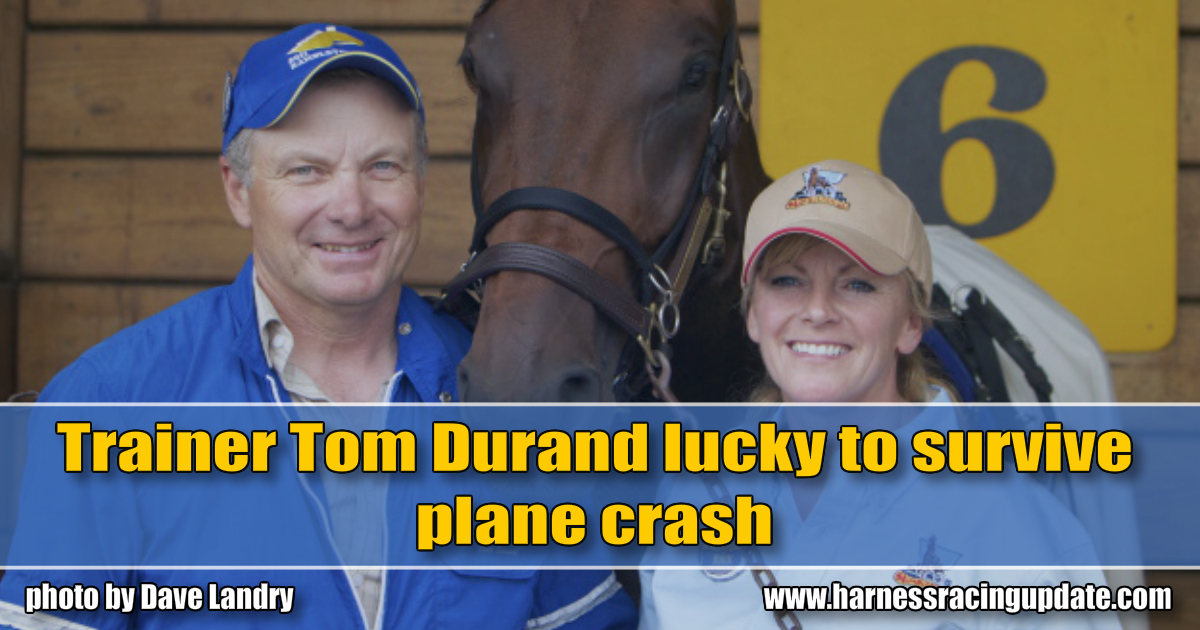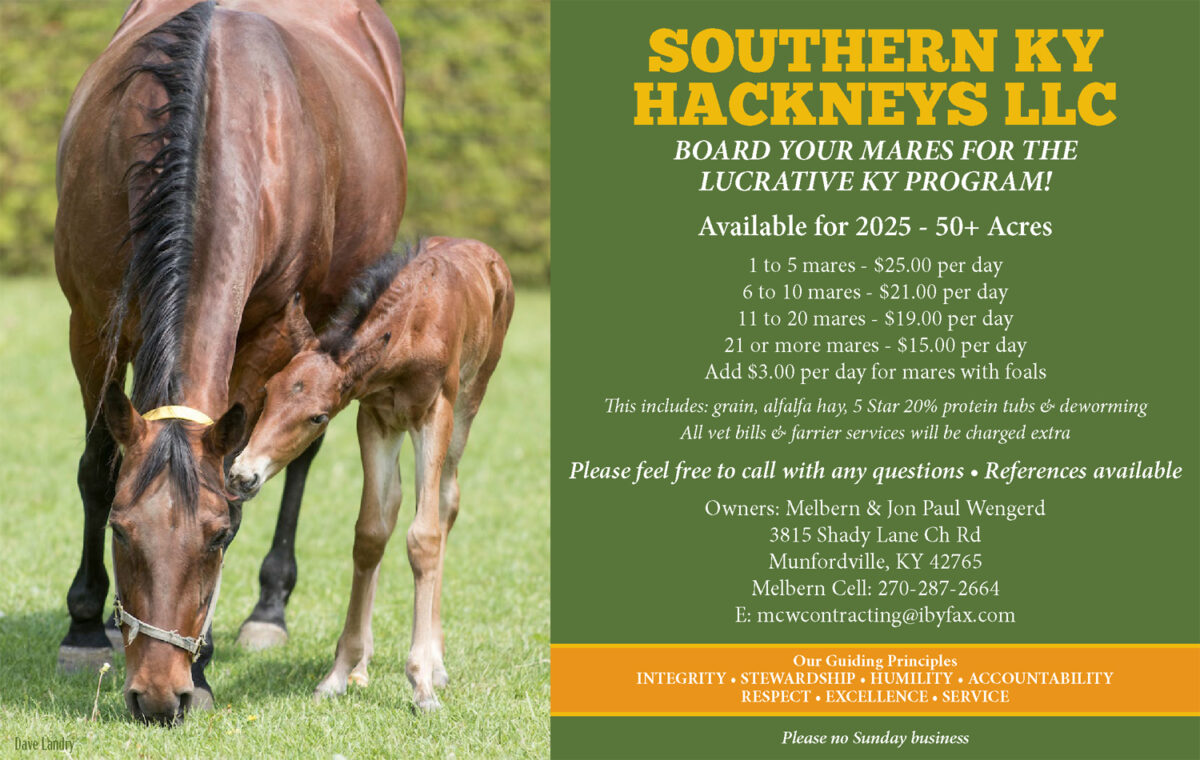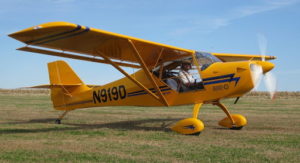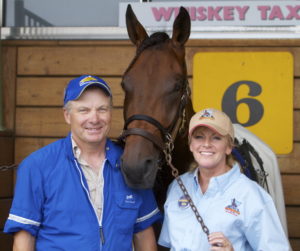Tom Durand lucky to survive plane crash on his farm
The pilot and trainer, who finished second in the 2011 Hambletonian with Whiskey Tax, crashed Monday on the infield of his farm track in Ontario after his plane’s engine failed shortly after takeoff.
by Dave Briggs
If not for his harness track and a split-second decision, trainer Tom Durand is certain he would have died when his engine failed and his plane crashed Monday morning (June 22) at his farm in Puslinch, ON shortly after takeoff.
“I guarantee I wouldn’t be talking to you today,” Durand said Wednesday.
Instead, Durand, 63, only suffered one broken vertebrae and spinal compression in the crash that destroyed his plane.
“The doctor came in after all the tests were back, and said, ‘Sir, this is your lucky day. I can’t find any major damage. There’s a spinal compression in all your joints, you’re going to be very sore tomorrow and, if we measured you, you’d be about an inch shorter than you were this morning,’” Durand said laughing.
ENGINE FAILURE
Durand, who finished second with Whiskey Tax in the 2011 Hambletonian won by Broad Bahn, said the engine on his yellow Aerotrek A-220 failed shortly after takeout from his farm landing strip.
“I got up to maybe 150 feet or 200 feet, somewhere in that range, I don’t know the exact height, and the engine started to die on me,” Durand said. “I lost power and I was thinking ‘Oh crap, what’s going on here?’ Then it picked up and it came back, so I thought, ‘Okay, maybe it was just a surge or something and I’m going to be all right.’ And then it started to go again. So, here I am and my brain is going 1,000 – ‘What’s my training say that I’ve got to do?’ Number one is ‘Fly the airplane.’ Number two is ‘At low altitude, with low energy, low airspeed, everything, you have to land straight ahead’ you don’t have enough energy to make a turn. You’ve got to find your best option, which is within 30 degrees of where you’re heading right now.
“So I’m looking at trees, I’m looking at rocks, I’m looking at a house and a forest. I’ve got no good options straight ahead. I’m going to kill myself flying into terrain.
“Somehow, magically in my brain, I say, ‘The engine is not completely dead, it is still producing a little bit of power.’ So I’m going to do what the book says that you’re not supposed to do and that is to make a turn.
“So, I did it. I made this gentle turn around to the left, which is the infield of my racetrack and I started bringing it around and bringing it around and I’m about a third of the way around – and I’ve already picked out where I’m going to try to set this airplane down in a level corner of this field – and I said, ‘Just give me a little more power and I’m going to make it.’
“About a third of the way around this turn, (the engine) quit.”
Durand said he was still about 100 feet off the ground and descending quickly.
“I was still trying to get oriented so I didn’t crash into the other trees that I’m looking at on the road. I still have to turn another 60 degrees or so to not hit something. I’ve got an airspeed of probably around 42 miles an hour, which is stall speed or just above stall speed. This is a tough place to be, but it’s manageable if you’ve done it before. You can fly an airplane at stall speed if you’re really, really careful.”
The wind had other ideas. When he turned back, the wind became a tail wind that cancelled out some of his airspeed, forcing the plane into what he called a “semi-stall” that resulted in an extremely hard landing.
“I guess you could call it a crash landing when you total the airplane,” he said.
JUNE WATCHED IN HORROR
Watching all this in horror was Durand’s wife, June, and some friends.
“At the instant I impacted, I felt this extreme pain right up my spine and I thought, ‘Oh man, I really messed something up.’ I thought, I don’t know how many bones in my back I just broke, but I know something is messed up. I didn’t have any other problems, no scrapes… I managed to get the door open and I crawled out. I’m lying on the ground waiting for (help) from some of these spectators…
“June was terrified, she was yelling and screaming at people to come and help. She got in her truck and drove it out to the infield. By this time, I’m lying out there just trying to shake off this pain and, miraculously, it was subsiding. I’m down to half the pain that I was having 10 minutes earlier. I said, ‘I think I’m going to be all right,’” Tom said.
“Next thing you know, we’ve got ambulances, fire trucks, police cars and everything all out there on my track.”
VETERAN PILOT
Tom, who has trained the winners of more than $8.2 million (Cdn), said he earned his pilot’s license in the 1980s.
“We were winter training at the South Florida Trotting Centre and the apartment that I had rented was on a direct path to the airport there (Lantana Airport in Palm Beach),” Tom said. “I was driving by there every day on my way to work and I’ve always wanted to fly and I told my wife, ‘I’m going to stop in there and check it out.’ So I had lessons and I signed up and had my license in 60 days. I went every afternoon. I trained horses in the morning and went flying every afternoon and I did it in a month.
“Over the years, I think I’ve owned nine different airplanes.”
While raising kids, Tom backed off flying — “I needed to invest in other things, like kids,” he said, laughing — but the passion to fly was still there.
“Seven or eight years ago I bought an airplane and I’ve been flying it around for all this time. It’s just a four-seater, single engine. I take it to Florida every winter and June and I take trips on it.
“I’ve always had this dream of being able to fly off my own property, so I didn’t have to go to the airport. Last year, I built this strip out behind my barn, but it’s short. The Cessna, the bigger airplane, was kind of marginal for flying out of this kind of strip, so I found this beautiful little two-seater airplane and it was just the ticket for flying out of a farm like this, so I bought it last summer. It’s a totally different kind of airplane to learn to fly. Even though it’s smaller and lighter, it was very difficult to transition into from what I’m used to flying, so I put in 10 hours with an instructor to really get familiar with it. Half of them were last fall and then the other half were this spring,” Tom said, adding the Aerotrek A-220 is a factory-made light sport aircraft constructed in Czechoslovakia and imported into North America through Indiana.
“There’s been 600 of them built, worldwide. They are very rare. There’s only about 120 of them in North America and there might only be about half a dozen in Canada – well, probably only five now.
“It’s been a very reliable aircraft, extremely well-made… This particular airplane was made in 2012 and it looked brand new.”
Tom normally keeps the plane at the Kitchener-Waterloo Airport, which is just a 12-minute flight from his farm. Last weekend, he flew it to Brantford to practice landings there and then flew it to his farm.
“A couple of family friends came over and I gave them rides,” Tom said. “We had a family get-together for Father’s Day.”
He decided to leave the plane at his farm for the night and take it back to the Waterloo airport on Monday morning. That’s when the accident happened.
Until that day, he said he hasn’t had a single problem with the plane.
“It ran perfect and then it just crapped out on me,” Tom said.
“When you do all your training as a pilot you’re trained for worst-case scenarios, and that is the worst thing that can happen to a pilot – loss of engine power on take-off, because you don’t have any options. You’ve got no altitude to work with, you’ve got no airspeed energy to work with, you’ve got nothing to work with and you’ve got to milk out what little you have and get something out of it.
“I had a plan. It was a plan that I put together in a matter of two seconds, but I really believed that it was going to work. It failed in the last few seconds because I landed too hard because of what I told you about the downwind turn, but… they say that any aircraft landing that you can walk away from is a good landing.”
In the meantime, personally training his small stable of five horses — including 12-year-old millionaire Whiskey Tax who finished third in a race at Grand River Raceway on Wednesday — will have to wait.
“I can’t get on a cart. I can’t lift anything over 10 pounds because my back can’t take the weight. It’s a little hard getting up and down,” Tom said.
GET BACK ON THAT HORSE
As for the plane, Tom said he needs to know why the engine failed.
“I don’t want to go on with my whole life and always wonder what was going on with that airplane,” he said. “We’re almost positive that it was in the fuel system somewhere. We know it’s not water. We know it’s not bad gas and we know it’s not contamination or anything like that, but it’s probably in the fuel pumps, the carburetors, something in the fuel system because it didn’t blow any cylinders or anything like that. It was starving for fuel, for some reason.”
He admits he was both composed and terrified in those frightening seconds and his initial instinct after surviving the crash was to never fly again. A friend helped him sort through his emotions.
“He was on the phone with me today and we talked it through and I’m already feeling confident about getting back in an airplane again because this is such a rare event. The chances of it happening to me again are really, really in my favor,” Tom said.
Just like horses, Tom Durand said flying is, “a disease. If you get bit by the bug, you cannot get rid of it.”




















